A friend recently asked me which hedge she should choose for her garden.
It’s a bit like being asked for the answer to world peace. It’s rather a big question.

Garden maker Posy Gentles uses a clipped low privet hedge in her front garden as a foil to the airy plants that float over the top.
The first step is to ask another question: What do you want your hedge for? To mark a boundary? Encourage wildlife? Are you looking for a hedge for privacy? And is there a ‘fashion in hedges’?

I cut elderberries, rosehips, hazel and wild currants from a mixed hedgerow near me. You can see a ‘meadow’ strip of grass and wildflowers at the base of the hedge just behind the basket.
Which hedge is in fashion now?
The biggest new trend in hedging is probably the increased popularity of mixed native hedging.
Morris Hankinson of Hope Grove Nurseries says that their mixed packs of native hedgerow mixes with themes are ‘our best-sellers’. They sell edible hedging or ‘hedges for foragers’, coastal hedging, ‘hedging for privacy’, ‘hedging for wildlife’ packs and more.

You can plant these ‘edible hedge plants’ as a mix or a single hedge.
I’m delighted by the idea of edible hedging or a ‘hedge for foragers’, made of hazel, blackthorn (sloe), dog rose (rose hips), wild pear, elder and crab apple.
The eradication of mixed hedges or hedgerows in the last 100 years has been a major issue in the loss of habitat for wildlife. Now environmentally-aware farmers are replacing mixed hedgerows where they can, but we can also push for them to be grown in parks, public spaces and private gardens.

Frances Beaumont’s narrow town garden (around 20′ x 50′) has won several wildlife-friendly awards. She has mixed hedging along both sides of the garden. Plants include passionflower, honeysuckle, quince, apples, blackberries and ivy.
A mixed wildlife or foragers’ hedge, if it is allowed to flower and fruit, will spread more than a tightly clipped hedge. Although, as you can see from Frances’ hedge above, you can train it not to take up too much space.
But, alternatively, why not consider having a sprawling, colourful hedge, with a strip of wildlife ‘meadow’ below rather than a traditional border?
How to decide which hedge is right for your garden
People ‘overthink their hedge choice’, says Morris. ‘There are only two things you really need to bear in mind.
If you’re planting a hedge in a shady spot, you need hedging that copes with shade. And if it’s a damp area, you need hedging that can cope with that. Apart from that, it’s all quite simple.’
In which case I suggest that you decide what you want to achieve with your hedge first. Here are some hedge ideas to inspire you.
Divide the space up with a hedge

This rather grand treatment at Doddington Place Gardens would also work in smaller gardens. Doddington Place Gardens, near Faversham, Kent, is open to the public in the summer.
If you want to break your garden up into ‘rooms’ or areas, hedging is a good option. This hedge with steps would work well in a long narrow town garden, especially one with a slight slope. You could terrace it. Box, yew and privet are the traditional hedges for this sort of treatment. Photinia can also be trimmed in shape.
Which hedge as a backdrop for garden colour?
If you want your hedge as a backdrop for garden colour, then you might want to choose a single species in a fairly plain green. These include box, privet, yew and griselinia, all of which make a good backdrop for flower colour.

Dark green yew makes a wonderful contrast for these flowers at Doddington Place Gardens
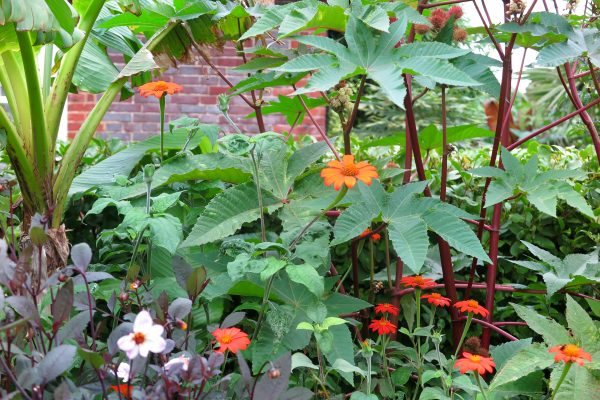
A waist-high griselinia hedge makes a backdrop for red and orange dahlias and ricinus at The Salutation Gardens in Sandwich. If the hedge wasn’t there, the border would feel less lush.
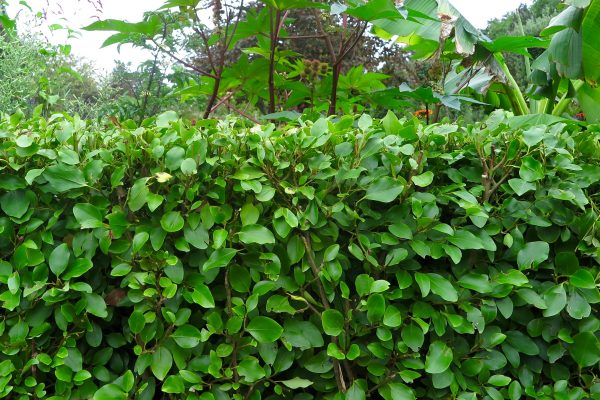
The other side of the griselinia hedge at The Salutation. It gives a neat edging to a path.
Other smart backdrops include beech, hornbeam and even cypress Leylandii, provided you keep it firmly trimmed.
Hedging as a punctuation point
Just as plain full stops and commas break up a sentence, gardens need their punctuation points too. Wonderfully lavish borders need a little geometry to give them structure.

Square boxes of box hedge anchor the airy, colourful planting in the Sunk Garden at Doddington Place.
Create shelter with a hedge
Hedges protect your garden from the wind better than fences do, because the wind is broken up by the hedging. With a fence or wall, the wind whistles over the top and can land on the other side with some force.
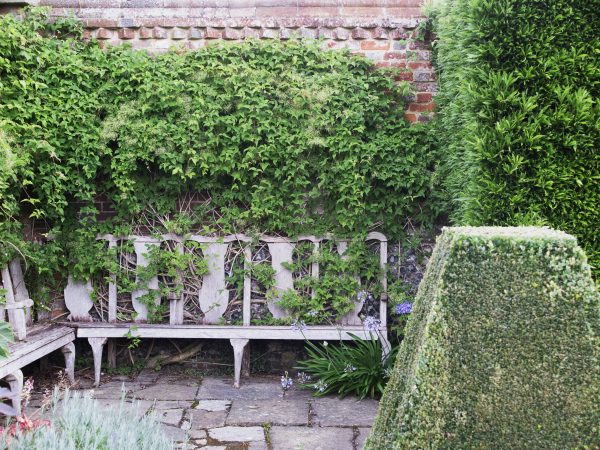
A hedge planted at right angles turns a wall into a sheltered corner at Doddington Place.

The veg garden at Rosemary Alexander’s Sandhill is sheltered from the beautiful landscape beyond with a hedge. This garden is open for the NGS (see website for dates)
You could easily use a mixed hedge here – an edible hedge might be perfect for a veg patch.
Do something different with hedging
If you’ve got plenty of space and about a hundred years to spare, you could do something like this with hedging. You could probably adapt this idea with a faster-growing hedging than yew – it would probably work with privet, for example.
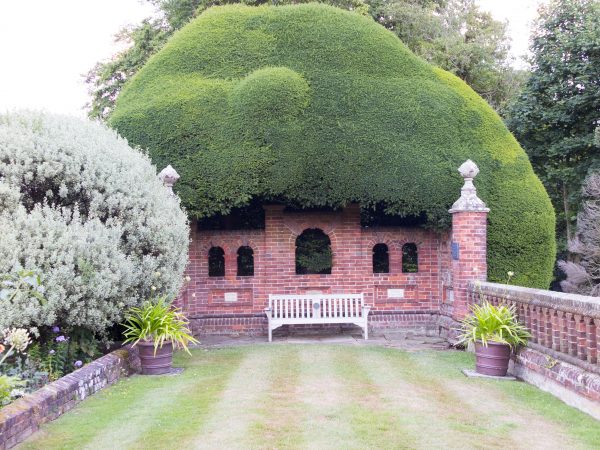
A seat by the pet cemetery at Doddington Place has a hedge ‘hat’.
Hedging as sculpture
You can frame a sculpture or a work of art with hedging.
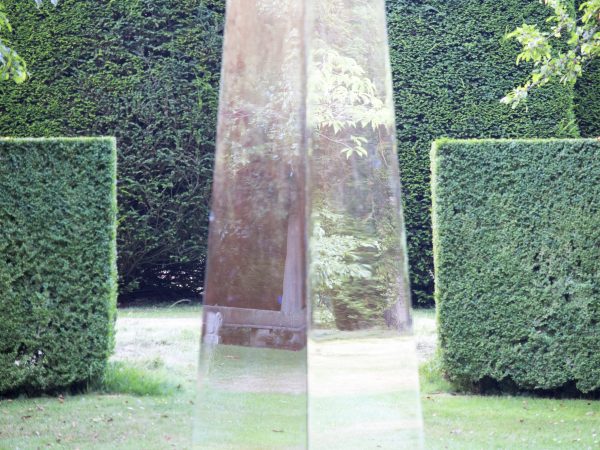
A glass mirror garden sculpture at Doddington Place Gardens, framed by box hedging.
Hedging as contrast
Smart tailored hedging makes a good contrast to wilder plantings, such as meadow strips.
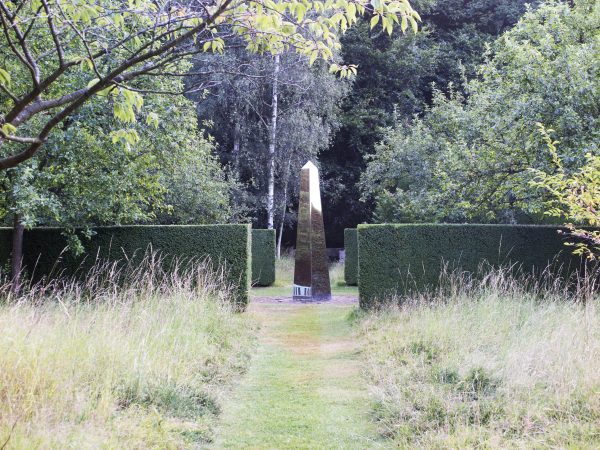
The linear formality of the hedges and mirror sculpture is contrasted with an informal meadow planting and simple mown path.

Pettifers is an outstanding garden of one and a half acres in Oxfordshire. It’s open to view by appointment. Here formal hedging creates contrast within a meadow area of the garden.
Equally, you could use a wonderfully rambling and colourful mixed hedge as a contrast to a smart lawn.
Hedges for wildlife
Wildlife need hedges both for shelter and food. An edible hedge will suit them very well, and mixed hedges offer the best range. Plants for a wildlife hedge include ivy, dog rose, blackthorn, elder, wild plum and hazel. If you want to know more about hedges for wildlife, see here.

Another stretch of Frances Beaumont’s ‘wildlife hedge.’ This is variegated elder – planted alongside ivy and honeysuckle (not shown).
Hedges for privacy
If you are thinking about hedges for privacy, be aware that a hedge is defined as ‘three trees in a row.’ Depending on whether there are any special rules and covenants where you live, you can often grow a hedge higher than a fence. Evergreen hedges offer more privacy, but less light. Deciduous hedges aren’t covered by legislation – or not in Britain, anyway.

Posy’s hedge is theoretically low for a privacy hedge, but the flowers dancing above it shield the windows from the eyes of passersby without affecting the light.
There’s more about planting evergreen hedges for privacy here. It specifically applies to Britain, but if you live elsewhere, it’ll give you an idea of what you need to check out before planting a hedge for privacy.
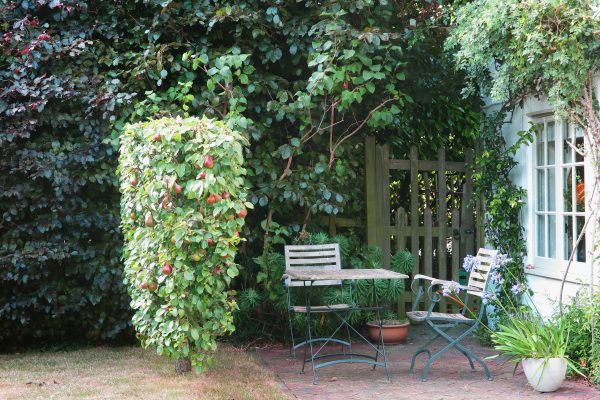
Pippa and James Rubinstein have screened a window and created a private seating area with a small, free-standing hedge of espaliered pear, clipped to remain only 5 feet high.
It may also be worth considering making your garden more private by placing just a single tree in the right place. There are 8 perfect-for-privacy trees here.
Hedges against pollution
A major international study lead by the University of Surrey recently concluded that hedging – even low hedges – is an excellent way of trapping particles of pollution and helping to keep the air near them clear.

This hedge helps protect the houses from car exhaust pollution. The trees and the hedges absorb carbon dioxide and release oxygen. The RHS is trying to encourage us all to plant some hedging in our front gardens and drives as part of their Greening Grey Britain campaign.
So far, no specific hedge plants have been suggested as better than any other for anti-pollution, so choose the hedge you like the best for other reasons.
Warning! Plant your hedge right – or else!
How you plant your hedge makes a huge difference to whether it grows well. The two pictures below show two yew hedges planted near a friend’s house. The yews came from the same nursery and were planted on the same day by the same people.
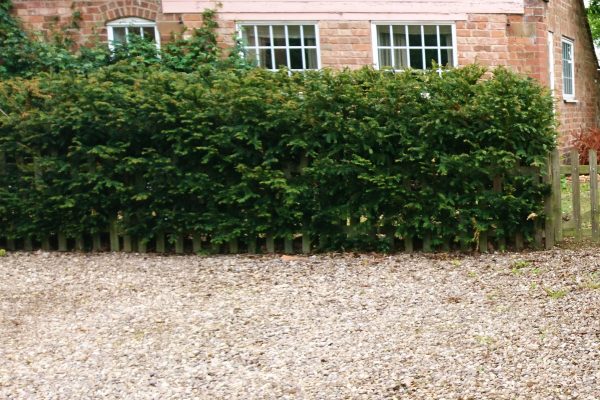
My friend’s yew hedge. This one was planted properly.
But one was planted into a ready-prepared trench with lots of compost and then well watered. The other – possibly because time was running out – was simply dug into the ground.

The same hedging plants in the same garden, planted on the same day – but without properly prepared soil and compost! Both hedges are now several years old, so poor planting has long-term effects.
You can download a guide to choosing, planting and looking after your hedge here:Hedging Guide from Hopes Grove Nurseries
And for ‘How to Plant A Hedge’ on YouTube, see here:
And look after your hedge in the first year
Hedges are reasonably low maintenance. Fences often need painting, repairing or replacing, but a hedge will go on forever with just an annual clip.
However, the first year is important, Morris says. This reflects what every other plant expert and nurseryman has ever told me. Trees and shrubs need looking after in their first year.
So you need to water and weed around your new hedging plants regularly in that crucial first summer.
So which hedge really is right for my garden?
Now that you have considered all the factors that matter, it’s time to talk to a hedge supplier. I don’t advise that you get your hedging from all-purpose garden centres, because every garden is different. It will really help to talk to someone knowledgeable, even on the phone.
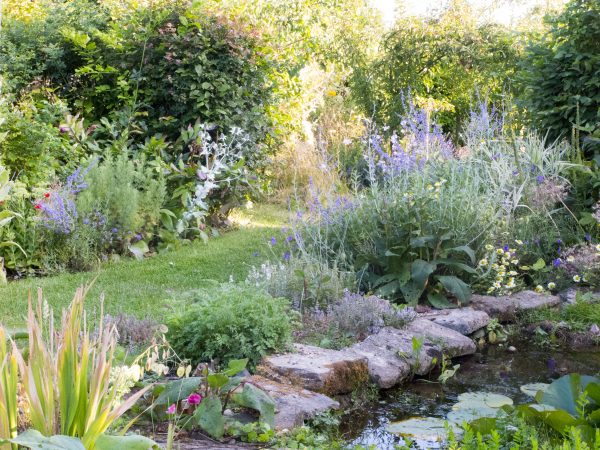
Kylie O’Brien’s one acre country garden (open by appointment via the NGS) overlooks fields, so her hedges act as windbreaks. So she chose hardy native plants, such as hazel, dog rose and field maple.
Once you’ve thought about what you want your hedge to do for your garden, you’ll probably have a shortlist of hedging possibilities. You’ll find a better range from a hedging supplier, and there’ll be experts who can confirm your choice will grow well in your garden.
The question of ‘which hedge’ is also about whether to buy cheaper, younger hedging or spend significantly more for an immediate impact.

This hedge of field maple, dog rose, elder, wild currant and hazel is now five years old, having been planted as ‘young whips’. It’s been looking like a ‘proper hedge’ for around two years.
Specialist plant/hedging nurseries will probably also be cheaper than garden centres. Bare root hedging, which can only be planted between November and March, often costs less than £1 a plant. But it takes 2-3 years – or more – before it will be the hedge of your dreams.
‘Instant hedging’ will cost at least ten times as much (literally!), but will look great immediately.
Writing this post has opened my eyes to the beauty of a good hedge. Instead of seeing a hedge as a mass of green, I now take pleasure in spotting dog rose, hazel, elderberries, sloes and more. Hedges are good for wildlife, and also good for the environment, and they are a good foil for the planting in your garden.
I’ve also started looking at gardens for their hedges, rather than their flowers. It’s an interesting new perspective, especially in terms of photography. Do give it a try!
Pin this for later:
The post Which hedge is right for my garden? appeared first on The Middle-Sized Garden.
from The Middle-Sized Garden http://www.themiddlesizedgarden.co.uk/which-hedge-is-right-for-my-garden/

No comments:
Post a Comment